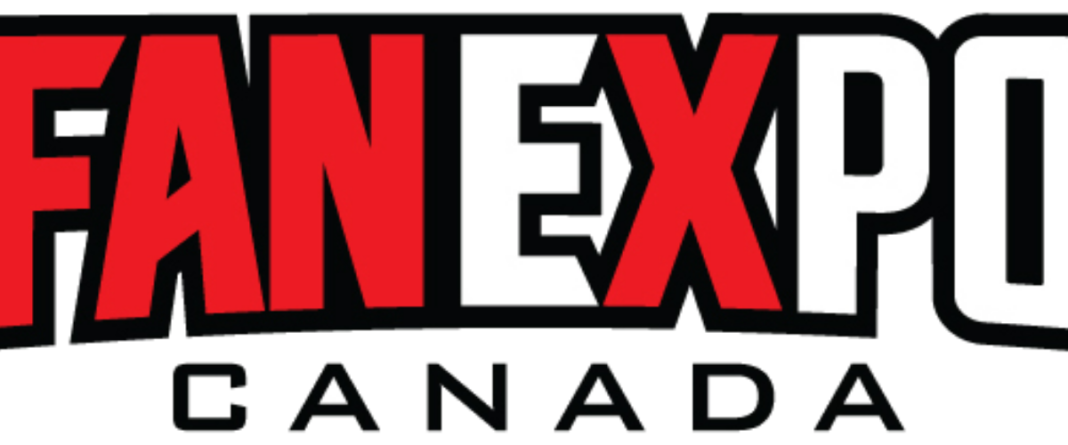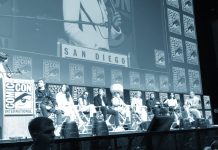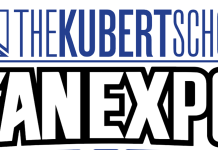If you’re reading this, chances are you wanted to make it into comics when you were a kid. You probably wanted to write, like I did. Before I caught the procrastination bug and never bothered to finish a story. Well, I should have apparently. At least that’s my takeaway from the “Breaking into Comics panel” I attended at Fan Expo Canada on Friday, featuring editor Heather Antos (Star Wars, Gwenpool), artists Mike Feehan (The Snagglepuss Chronicles), Leisha Riddel (Smooth Criminals), and Jenn St. Onge (Bingo Love). The panel was moderated by Brent Chittenden, host of the True North Nerds podcast.
Chittenden began proceedings by asking the audience to cheer for the panelists, which produced a more lukewarm response than anyone was expecting. Chittenden attributed this to collecting aspiring comic creators and introverts all into one room, hence the low volume. When introducing the topic of the panel, he admits that comics can be a faceless medium so the panel was the audience’s chance to put faces to names and to learn something from these accomplished creators.
Antos interrupts Chittenden, asking the audience which aspect of comics they were interested in working in. Most of them were writers and artists, with a couple raising hands to identify themselves as potential editors. In a whisper she jokingly claims that those people are the best, and relayed a story of herself attending a panel at C2E2 a few years ago and being the only person in the audience to want to be an editor.
Since editors are an element of a comic book’s creative team that aren’t as recognised as other team members, the conversation turned to another unappreciated art form, that of inking. Chittenden laments that inking is a dying art, with Riddel adding that inking isn’t as coveted a job as it was many years ago. A lot of artists work digitally now and tend to digitally ink themselves rather than hand their pages to someone else.
Chittenden begins the panel in earnest, asking each panelist about their background and how they broke into the industry. Riddel begins; she graduated from Sheridan College in animation back in 2010, and worked in television and video games here in Toronto. She’s mostly known for posting rants online, and was noticed by BOOM! editor Shannon Waters. Waters knew of Riddel from a web comic she posted but took it down as she wanted it published traditionally instead. Riddel was apprehensive about interior work but before she knew it, she completed her first series so she was in.
St. Onge takes her turn. She graduated from Seneca College in 2012 in independent illustration After graduating she realised she didn’t necessarily need to go to college to learn about art. She worked an office job for two years and didn’t enjoy herself at all, and attempted to work as a freelancer in 2013 for six months to no avail. She was barely drawing anything at this point, which leads her to responding to a Tumblr post asking for an artist for a project. Despite not having a huge portfolio, she got the job which lead to projects like Finding Molly and Jem and the Misfits. She’s been making comics literally every single day for the past four years, which blew the panel away given she hasn’t had a weekend to herself in years.
An audience member raises their hand to ask a question, asking for clarification on St. Onge’s statement that school wasn’t worth it. Antos chips in, saying that the industry doesn’t care about your education but cares about portfolios. She admits that some artists do need structure so an education might serve them well, but ultimately everyone has their own journey.
Riddel echoes what Antos said, saying that she herself needed the structure. The skills she learned in school are what she has been using every day at work, so she has found value in a formal education despite having learned a lot about the industry herself. St. Onge studied art fundamentals for two semesters which was incredibly valuable for her, but she didn’t need to pay for school. She could have done it herself, and instead relied on Twitter than any contacts she could have made while in school. Riddel concludes by mentioning that Canadian artists with a bachelor’s degree in art will have an easier chance getting a work visa in the United States if they wanted to work there. It’s either that or five years’ relevant experience which can be hard for a lot of people.
Antos gets back to Chittenden’s question about their journeys. She has a film and theatre background, and drew all the time before even learning about comics. She had no idea comics were a viable career option for her until her early 20s when she realised she didn’t want to pursue film and theatre. Panicking and not knowing what to do, she turned to a friend who reminded her that she loved comics: why didn’t she pursue that? That was Antos’ eureka moment, and began learning about the different rules in the industry. She didn’t want to be a writer or artist and wanted to see where she could fit. Antos was aware of what editors did in traditional publishing but soon learned that comics are so far removed in every way. She noted that her favourite books were edited by the same one or two people and met Jordan White, the current X-Men editor. Antos began self-publishing and was surprised when she got to the point that people were paying her to edit their books. “Your mistakes are my job security,” she joked. Six months later, she ran into White at New York Comic Con and talked to him about her progress. At the time Marvel was hiring a bunch of assistant editors and she was hired. She says she’s still figuring out what an editor does.
Mike Feehan has his turn after remaining quiet for the entire panel up to this point. He was born and raised in Newfoundland and loved reading and drawing comics. As he got older he realised it was more or less impossible to get into comics while living in Newfoundland. Despite his college instructors telling him he’d do great work in comics, he instead pursued graphic design. He discovered he wasn’t good at that so he saved money and travelled to a bunch of conventions for portfolio reviews. After arriving at his first Fan Expo he was shocked at the support artists had there since he didn’t have anyone to turn to in his small town. He kept going back to the con year after year and only ever got offers from small press publishers. They offers exposure instead of payment which he took, but after a while he couldn’t take it anymore. Jim Chadwick from DC offered him a miniseries which ended up being The Snagglepuss Chronicles with Mark Russell.
Another audience member raises their hand, asking about promises of exposure rather than payment and if anyone at the panel would recommend it. Riddel bellows out a large “DON’T” to the delight of the crowd and panel.
St. Onge clarifies, saying that if someone approaches you offering exposure, then they don’t have a base large enough to make it worthwhile. The only time you should ever do it is if it’s spec work for a large company, and sometimes that even pays. Only ever work for exposure for yourself.
Antos advises writers on this whole dilemma, recommending that they start by writing one to four page stories and collect them. Their first work isn’t going to be an ongoing, but rather a backup or a short story. If you have a collection of short comics then you can show much more range as a writer. Print an ashcan, write romance, comedy, action, horror, and superhero stories. Riddel concludes with saying that doing work for exposure hurts the freelance economy as that client will go to the next person and say that you did the work for free, so why should that next person be charging?
Another question is asked, this time about getting started out and striving for decent quality in their work. Riddel tells them to go to Creators Resource, a website that collects page rates from different publishers for different art work like inking or penciling. Antos adds that a lot of artists undercharge because of the current economy and are afraid of losing work. St. Onge states that from the point-of-view of an artist, it’s reasonable when contacting an artist to give them a breakdown of a story and ask for a budget. That way they’ll know you want to pay them and want to know what your rate is.
An audience members asks about how editors will judge a writer’s work based on the artists they work with, and of how a writer is generally evaluated. Antos would never say that a writer isn’t good based on the quality of the artwork. The thing with editors is that they don’t read spec scripts and want to see your comics. Can you collaborate? Can you get a finished product done? How’s your dialogue? With a good artist, an editor can flip through their work and not need to read dialogue. When you add dialogue, editors should be able to read it and get a sense of who’s talking.
Another question pops up about anything that’s surprised the panel when they broke into the industry. For Antos, sitting in on quarterly meetings with sales numbers and digital sales, seeing what’s outselling what and the decisions that get made on that level was more fascinating than surprising for her.
St. Onge laments that when drawing as a kid you get tons of positive reinforcement from friends and family, but as a freelancer it’s something you’re actively looking for. And, there aren’t any weekends. Riddel says that she had to force in boundaries, to make weekend plans and couch and video game appointments. You can’t work 24/7 all the time because you’ll die, unlike St. Onge. You will find yourself falling out of love with art and look at your drawings and think that you suck, but you have to remind yourself of why you love art and comics.
Antos agrees that boundaries are important, and that despite working with superheroes and cats it’s still a job. You’re going to have days where you hate what you do and who you work with, and deal with inner office politics. You have to remember that like with any other job, you’ll need to leave your shit at the door and do your job. Feehan jumps in and says this panel has been satisfying for him because he thought he was the only one dealing with all of this.
One audience member asks the panel where they can find artistic collaborators in the first place. Antos says that the Comics Experience website run by Andy Schmidt is a good resource and can teach you things from how to write a pitch or a one-shot, to inking or colouring a comic. There are forums featuring a lot of professionals including Schmidt himself and writers like Cullen Bunn who will answer questions. These forums have a lot of artists looking for writers and vice versa.
Someone asks about self-publishing tips. Antos says do just put them out there as there hasn’t been a better time than now to publish your own work. Web comics, ComiXology, and Instagram comics are all viable options for aspiring creators. She says you’ll never know who’s going to read it.
With that, the “Breaking into Comics” panel concludes. Chittenden thanks the audience for having attended the panel and asks for a round of applause for the panelists.







